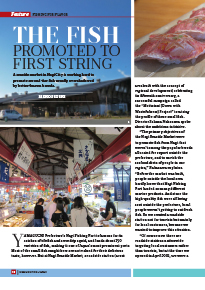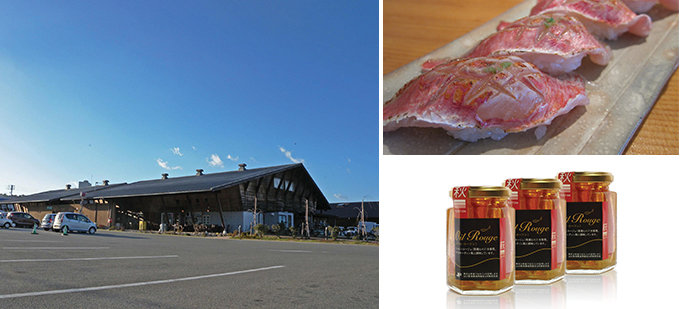Home > Highlighting JAPAN >Highlighting Japan July 2015>Fishing for Flavor
Highlighting JAPAN

Fishing for Flavor
The Fish Promoted to First String
A seaside market in Hagi City is working hard to promote second-tier fish usually overshadowed by better-known breeds.

Yamaguchi Prefecture’s Hagi Fishing Port is famous for its catches of tilefish and swordtip squid, and lands about 250 varieties of fish, making it one of Japan’s most prominent ports. Most of the small fish caught here are not valued for their delicious taste, however. But at Hagi Seaside Market, a roadside station (a rest area built with the concept of regional development) celebrating its fifteenth anniversary, a successful campaign called the “Mottainai [Down with Wastefulness] Project” is raising the profile of these small fish. Director Sakana Nakazawa spoke about the ambitious initiative.
“The primary objectives of the Hagi Seaside Market were to promote fish from Hagi that weren’t among the popular breeds allocated for export outside the prefecture, and to enrich the seafood diets of people in our region,” Nakazawa explains. “Before the market was built, people outside the local area hardly knew that Hagi Fishing Port landed so many different marine products. And since the high-quality fish were all being sent outside the prefecture, local people weren’t getting to eat fresh fish. So we created a roadside station not for tourists but mainly for local customers, because we wanted to improve this situation.
“Of course now there are roadside stations nationwide targeting local customers rather than tourists, but at the time we opened in April 2001, we were a pioneering presence,” Nakazawa continues. “Because of the influence of a popular TV drama set in Hagi, we’ve seen an increase in visitors from outside the prefecture, but still the majority of our customers are from within the prefecture.”
A five-year program beginning in 2009, the Mottainai Project attracted about thirty participants from local fishery cooperatives, marine product processing companies, the Chamber of Commerce and Industry and so on. The Hagi Seaside Market ran the project, which involved the entire city.
“When we surveyed the local fishermen, we learned that kintaro (mullet), which locals traditionally consumed dried whole or fried as tempura, was actually very delicious when eaten raw as sashimi,” Nakazawa relates. “Fish that tastes great as sashimi has power, by which I mean it has a wide range of applications. A type of small whitefish, kintaro resembles tilefish but has a richer flavor. As we continued our research, we discovered that it was a species related to a fish considered a delicacy in France called rouge. So we renamed it ‘Japanese Rouge’ and, borrowing the talents of the famous Italian cuisine chef Masayuki Okuda, created a confit dish called ‘oil rouge.’
“Picked up as a dinner item at Tokyo’s Imperial Hotel, oil rouge was served at the dinner party for the World Economic Forum Annual Meeting in Davos in January 2011, and even to the Pope,” says Nakazawa. “I believe that its incredible success is all due to Chef Okuda. Before this, fishermen would throw kintaro back into the ocean when they overfished it, but now it has become a major item locally, even being served as a three-item sashimi dish at izakaya restaurants.”
Currently, as part of the “Hagi Gyosyokuoukoku [Hagi Seafood Dining Kingdom] Project,” with collaboration from luminaries such as Italian cuisine chef Mamoru Kataoka and washoku chef Hiromitsu Nozaki, similar efforts are being made to boost the image and value of tilefish to greater levels as a premium fish. Starting in July 2015 as part two of the Mottainai Project, there is a plan is to develop women-only teams to commercialize inexpensive and unfamiliar fish, make them into equally appealing products and promote them nationwide.
“Other ports are working to commercialize their small fish, and I’ve been consulted on some of these efforts, but there are still plenty of fish with potential all over the country,” Nakazawa claims. “First we have to spread the word about the appeal of these fish domestically, and if we can expand that message to overseas markets that would make me very happy.”
While five years ago the market price for kintaro was around ¥200 per kilo, it currently averages ¥400, and has reportedly reached as high as ¥1,800. Fish prices that climb too high can present a problem, but Nakazawa smiles as he speaks about achieving the goal of raising fish prices to reduce the hardships of the local fishing community.
© 2009 Cabinet Office, Government of Japan






